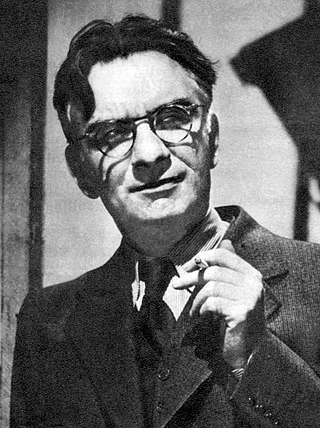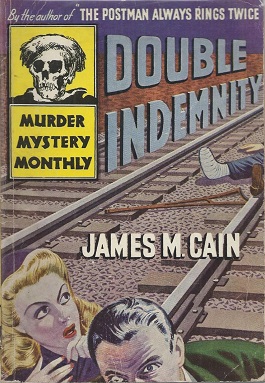
James Mallahan Cain was an American novelist, journalist and screenwriter. He is widely regarded as a progenitor of the hardboiled school of American crime fiction.

The Postman Always Rings Twice is a 1934 crime novel by American writer James M. Cain. The novel was successful and notorious upon publication. It is considered one of the most outstanding crime novels of the 20th century. The novel's mix of sexuality and violence was startling in its time and caused it to be banned in Boston.

A werecat is an analog to "werewolf" for a feline therianthropic creature.

The Postman Always Rings Twice is a 1946 American film noir directed by Tay Garnett and starring Lana Turner, John Garfield, and Cecil Kellaway. It is based on the 1934 novel of the same name by James M. Cain. This adaptation of the novel also features Hume Cronyn, Leon Ames and Audrey Totter. The musical score was written by George Bassman and Erich Zeisl.

Gay's Lion Farm was a public selective breeding facility and tourist attraction just west of the south-east junction of Peck Road and Valley Boulevard in El Monte, California. It operated from 1925 through 1942, when it was closed temporarily due to wartime meat shortages. It never reopened.

Double Indemnity is a 1943 crime novel by American journalist-turned-novelist James M. Cain. It was first published in serial form in Liberty magazine in 1936 and later republished as one of "three long short tales" in the collection Three of a Kind.

She Made Her Bed is a 1934 American pre-Code romantic drama film directed by Ralph Murphy and written by James M. Cain, Casey Robinson and Frank R. Adams. The film stars Richard Arlen, Sally Eilers, Robert Armstrong, Grace Bradley, Roscoe Ates and Charley Grapewin. It was released on March 9, 1934, by Paramount Pictures and was described at the time as a "social drama" film in which Arlen plays a "heroic villain."
“Pastorale” is a short story written by James M. Cain and published in 1927 by editor H. L. Mencken in The American Mercury. Written in the Ring Lardner style, the tale is told in a first-person narrative, delivered in the dialect of a resident of rural America. Both the point-of-view and the use of colloquial dialect for his protagonists, fully established in “Pastorale”, would be applied in many of Cain’s novels.
Career in C Major is an opera-themed novella by American writer James M. Cain, first published in 1938. First appearing as a serial in The American Magazine entitled "Two Can Sing", this comic romance is a departure from Cain's first novels, Postman Always Rings Twice (1934) and Double Indemnity (1936), both hardboiled crime stories that included premeditated murder. Redbook magazine, disappointed that Cain had exchanged his hard-boiled themes involving sex and murder for a "comedic adventure", declined to purchase the novella but Liberty obtained the piece and carried it as a serial in 1935.

Three of a Kind is a collection of three novellas by James M. Cain, published by Alfred A. Knopf in 1943. Each originally appeared as serials in magazines during the 1930s. The collection includes Double Indemnity, first published in 1935 as a serial for Liberty magazine; Career in C Major, originally entitled "Two Can Sing" when it appeared in The American Magazine in 1938; and The Embezzler, appearing in Liberty as "Money and the Woman", also in 1938.

Serenade is a novel by James M. Cain published in 1938 by Alfred A. Knopf. and one of four Cain novels to feature opera as a plot device. Loosely based on Bizet's Carmen, the story explores the sources of artistic development, in particular the role played by sexual orientation in the development of artistic talent.
The Embezzler is a 1938 short novel by James M. Cain. The work first appeared as a serial in Liberty magazine in 1940 under the title Money and the Woman. In 1943, Alfred A. Knopf published the work as The Embezzler in a collection of novellas by Cain entitled Three of a Kind.

Love's Lovely Counterfeit is a hard-boiled short novel by James M. Cain published by Alfred A. Knopf in 1942. The story is set in a Midwestern town where rival gangsters struggle to maintain control of their criminal enterprises. The work is one of only three of Cain's novels told from the third-person point-of-view.

Past All Dishonor is a historical novel by James M. Cain published by Alfred A. Knopf in 1946. The story is set during the American Civil War concerning a tragic love affair between a Confederate spy and a mining-camp prostitute in California and Nevada. The novel, praised by many critics, was one of Cain's most profitable literary successes.

The Butterfly is a hard-boiled novel by author James M. Cain published by Alfred A. Knopf in 1947. The story is set in rural West Virginia in the late 1930s and concerns a mystery surrounding an apparent case of father and daughter incest.

Our Government is a collection of satirical dialogues and sketches by James M. Cain published in 1930 by Alfred A. Knopf as part of The American Scene series. Our Government is the first of Cain's many books.
The Taking of Montfaucon is a short story by James M. Cain first published in H. L. Mencken’s The American Mercury in 1929.
Crashing the Gates is a play written by James M. Cain and produced by Philip Goodman in 1926. The play’s plot dramatizes the labor struggles in the West Virginia coal mines of the 1920s and the evangelical Christian fundamentalism prevalent among poor whites in the region. The tragic denouement anticipates the exposure of pseudo-clericism in Sinclair Lewis’ Elmer Gantry (1927).
The Postman Always Rings Twice is a play by James M. Cain, based on his best-selling 1934 novel The Postman Always Rings Twice. The work was first performed at the Lyceum Theatre in New York City in 1936. The play saw a brief revival in 1953.

Galatea is a romance novel by James M. Cain published by Alfred A. Knopf in 1953. The story alludes to the mythological Galatea in which the sculptor Pygmalion falls in love with the ivory figure of a woman he has crafted. In Cain’s modernized version of the Greek legend, an overweight woman is transfigured through a program of weight reduction into a goddess-like beauty.